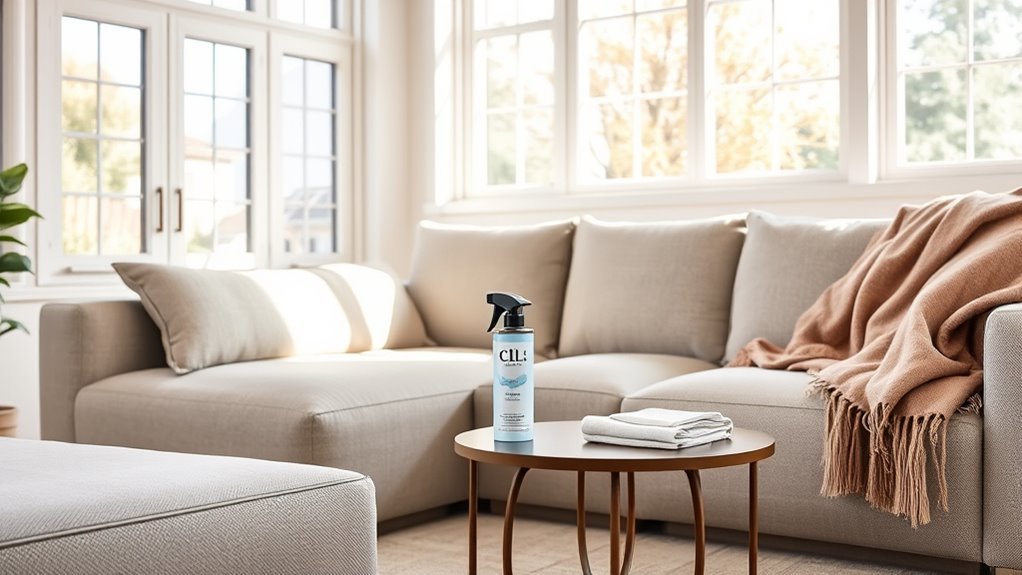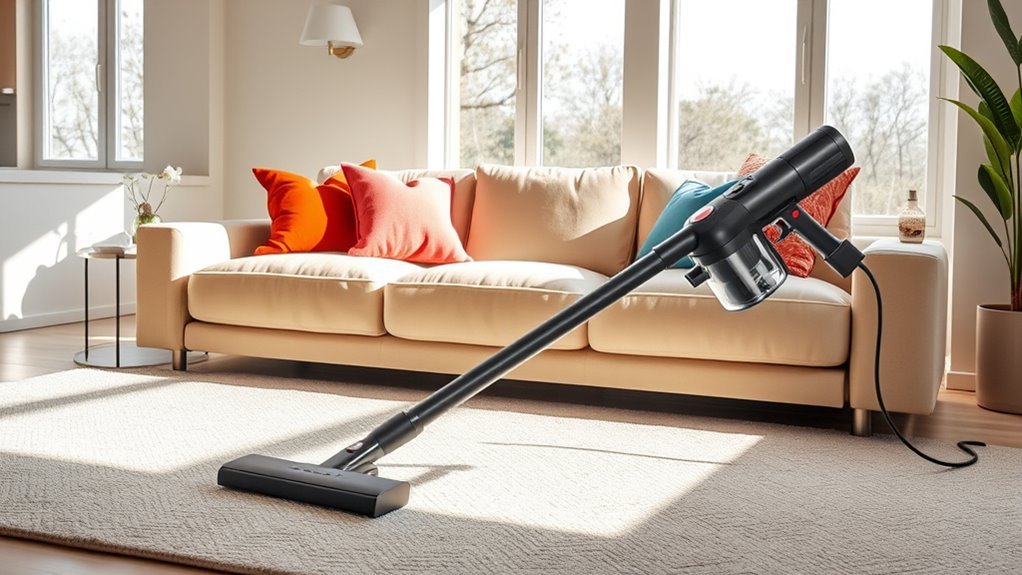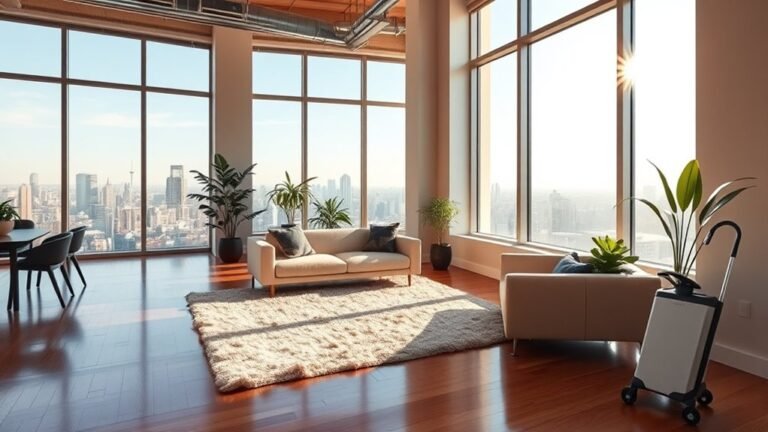How to Reduce Cleaning Costs in Couch
To reduce couch cleaning costs, choose easy-to-clean materials like microfiber or leather and protect surfaces with washable covers. Stick to a regular cleaning schedule that includes frequent vacuuming and prompt stain treatment to avoid deep damage. Use affordable DIY solutions such as vinegar and baking soda to clean effectively without expensive products. Train pets to stay off the couch and groom them regularly to minimize messes. With these methodical steps, you’ll maintain a fresh, durable couch while saving money—there’s much more to explore for lasting care.
Choose Couch Materials That Are Easy to Clean

When you’re selecting a couch, opting for materials that are easy to clean can greatly cut down your long-term maintenance costs. Focus on fabric choices like microfiber, leather, or tightly woven synthetic fibers, which resist stains and require minimal effort to maintain. You’ll find microfiber particularly forgiving; it repels liquids and can be spot-cleaned with simple soap and water. Leather, while pricier upfront, cleans easily with a damp cloth and occasional conditioner, reducing the need for deep cleaning. Avoid delicate fabrics like silk or velvet, which demand specialized cleaning techniques and professional care. By prioritizing durability and ease in your fabric choices, you free yourself from constant upkeep hassles, ultimately saving both time and money while enjoying your living space with less worry.
Establish a Regular Cleaning Schedule
Although it might seem tedious, establishing a regular cleaning schedule for your couch is essential to prevent dirt buildup and extend its lifespan. Start by determining the cleaning frequency based on your lifestyle—busy households may require weekly attention, while quieter spaces can manage with biweekly or monthly care. Incorporate this schedule into a consistent maintenance routine, including vacuuming crumbs, wiping spills immediately, and rotating cushions to avoid uneven wear. Stick to your plan to avoid costly deep cleans or premature replacement. By methodically following your maintenance routine, you preserve your couch’s appearance and comfort, giving you more freedom to enjoy your space without the hassle of unexpected cleaning emergencies or expenses. A well-planned schedule keeps your couch fresh and your budget intact.
Use Affordable DIY Cleaning Solutions

Maintaining a regular cleaning schedule lays the groundwork for a well-kept couch, but you don’t have to rely on expensive commercial products to keep it looking fresh. You can make effective homemade cleaners using simple natural ingredients like vinegar, baking soda, and lemon juice. For instance, mixing equal parts white vinegar and water creates a gentle yet powerful upholstery spray that tackles stains and odors without harsh chemicals. Baking soda sprinkled on the fabric before vacuuming lifts dirt and neutralizes smells efficiently. These DIY solutions not only save you money but also give you control over what touches your couch, aligning with your desire for freedom from toxins and unnecessary expenses. By embracing affordable, natural cleaners, you maintain your couch’s appearance while being budget-conscious and eco-friendly.
Protect Your Couch With Covers and Throws
You can markedly cut down on cleaning expenses by using couch covers, which shield your furniture from spills, dirt, and everyday wear. When selecting throws, focus on durable, washable fabrics that blend well with your decor and withstand frequent use. Taking these steps not only preserves your couch’s appearance but also reduces the need for costly professional cleanings.
Benefits of Couch Covers
Since your couch faces daily wear and potential spills, using covers and throws offers a practical shield that greatly cuts down on cleaning efforts. Couch covers enhance fabric durability by protecting against stains, pet hair, and fading from sunlight, extending your couch’s lifespan. They act as a barrier, so you’re not constantly deep-cleaning the original upholstery. Additionally, covers allow you to maintain couch aesthetics without committing to permanent changes or costly reupholstering. You can easily swap them out to refresh your living space’s look while preserving your freedom to adapt style as desired. By investing in quality covers, you save both time and money on cleaning, making upkeep more manageable and less frequent, all while protecting your couch from everyday damage.
Choosing the Right Throws
Beyond couch covers, selecting the right throws can further protect your furniture while adding comfort and style. Start by evaluating throw materials—opt for durable, machine washable fabrics like cotton or microfiber to ease cleaning and extend longevity. Consider color selection carefully; choosing hues that blend with your design aesthetics helps maintain a cohesive look while hiding stains. Texture variety adds depth and tactile appeal, so mix smooth and nubby throws for layered warmth. Adjust throws seasonally, swapping heavier weaves for lighter ones to enhance comfort. Layering techniques not only protect your couch but allow you to refresh your space effortlessly. Finally, perform a cost comparison to balance quality with budget, ensuring your throws serve practical protection without compromising your freedom to enjoy a stylish, low-maintenance couch.
Vacuum Frequently to Prevent Dirt Buildup

Regularly vacuuming your couch is one of the simplest yet most effective ways to keep dirt and debris from settling deep into the cushions and fabric. To master vacuuming techniques, start by using a vacuum with adjustable suction and a brush attachment designed for upholstery. Move methodically across every surface, including crevices and seams, where dirt tends to accumulate unnoticed. This routine dirt prevention not only maintains your couch’s appearance but also extends its lifespan, saving you money on professional cleanings or replacements. Make vacuuming a habit—weekly sessions prevent buildup that’s tougher to remove later. By doing so, you maintain freedom from stubborn grime and odors, keeping your living space fresh and inviting without unnecessary expense or hassle.
Promptly Treat Stains to Avoid Deep Damage
When you notice a stain, act immediately by blotting it gently instead of rubbing, which can push it deeper into the fabric. Choose the right cleaning agent based on your couch material to avoid causing further damage. Prompt, careful treatment prevents stains from setting and reduces costly deep cleaning later.
Immediate Stain Action
The first few minutes after a spill are essential for preventing permanent stains on your couch. Taking immediate actions can drastically reduce stain removal costs by stopping the stain from setting deeper. You’ll want to blot gently with a clean cloth—never rub—to lift excess liquid without spreading it.
| Step | Action |
|---|---|
| 1. Blot | Use a clean, dry cloth |
| 2. Apply Pressure | Gentle, to absorb liquid |
| 3. Avoid Rubbing | Prevent fibers from damage |
Act swiftly and methodically. This precise approach gives you freedom from costly deep cleaning or replacement, ensuring your couch stays fresh and stain-free longer.
Use Appropriate Cleaning Agents
Although quick action on stains is essential, using the right cleaning agents immediately afterward can make all the difference in preventing deep damage. You’ll want to choose fabric safe solutions tailored to your couch’s material to avoid discoloration or weakening fibers. Eco friendly cleaners are excellent because they’re gentle yet effective, reducing chemical buildup and preserving your couch’s integrity over time. Before applying any product, test it discreetly to validate compatibility. Applying the appropriate cleaner promptly halts stain penetration, saving you from costly professional treatments later. By being methodical and selecting the right agents, you maintain your couch’s appearance and durability, giving you freedom from frequent, expensive cleanings. This careful approach helps you protect your investment and keeps your living space fresh and inviting.
Blot, Don’t Rub
Since stains can quickly set into your couch fabric, you’ll want to act immediately by blotting the spill rather than rubbing it. Blotting techniques involve gently pressing a clean, absorbent cloth onto the stain to lift liquid without spreading it. Avoid rubbing, as rubbing consequences include pushing the stain deeper into the fibers and causing fabric damage or discoloration. Use a dabbing motion, starting from the edges and moving inward to prevent the stain from expanding. Remember, patience is key—press and lift repeatedly instead of scrubbing. This method preserves your couch’s material integrity, saves you from costly professional cleanings, and keeps your living space feeling fresh and free. By mastering blotting techniques, you control stains efficiently and extend your couch’s lifespan with minimal effort.
Train Pets to Minimize Couch Messes
How can you effectively train your pets to keep your couch cleaner and reduce unwanted messes? Start by establishing clear pet boundaries so your furry friends know which areas are off-limits. Use positive reinforcement consistently—reward them with treats or affection when they stay off the couch or use designated pet beds. Here’s a methodical approach to help:
- Set physical barriers or use pet deterrent sprays on the couch to discourage access.
- Create a cozy, inviting space for your pet nearby to redirect their attention.
- Maintain a regular grooming schedule to minimize shedding and accidental stains.
Frequently Asked Questions
Can Professional Steam Cleaning Damage My Couch Fabric?
You might worry that professional steam cleaning could damage your couch fabric, but with proper steam cleaning safety, it’s generally safe. Different fabric types react differently—natural fibers like cotton or linen can handle steam better than delicate materials like silk or velvet. Professionals usually test a small area first to avoid damage. So, as long as you understand your couch’s fabric type and trust experienced cleaners, you’ll keep your couch safe and fresh.
How Often Should I Deep Clean My Couch Annually?
You should aim for at least one annual cleaning of your couch to maintain its freshness and longevity. Deep cleaning helps remove embedded dirt, allergens, and stains that regular vacuuming can’t tackle. If you have pets or kids, consider deep cleaning twice a year. This methodical approach keeps your couch looking great without overdoing it, giving you the freedom to enjoy a clean, comfortable space without constant upkeep.
Are There Specific Cleaning Products to Avoid on Leather Couches?
It’s tempting to grab any cleaner when your leather couch looks dull, but harsh chemicals like bleach or ammonia can ruin leather care by stripping oils and causing cracks. Instead, carefully choose pH-balanced, leather-specific products or natural cleaning alternatives like diluted vinegar or mild soap. You’ll preserve your couch’s freedom to age gracefully while avoiding damage. Always test a small area first and moisturize leather afterward to maintain its supple texture and longevity.
Does Humidity Affect the Frequency of Couch Cleaning?
Yes, humidity levels definitely impact your cleaning schedule. When humidity is high, moisture can cause mold or mildew to develop on your couch, especially if it’s fabric. You’ll need to clean and air out your couch more frequently to prevent damage. Conversely, in drier climates, dust buildup might be your main concern, requiring regular vacuuming. Adjusting your cleaning schedule based on humidity helps maintain your couch’s condition and extends its lifespan.
Can Fabric Protectors Cause Discoloration Over Time?
Yes, fabric protectors can sometimes cause discoloration over time, especially if you don’t choose the right product for your couch’s material. For effective fabric care, always test protectors on a hidden spot first. Follow cleaning tips carefully—avoid harsh chemicals and excessive application. This way, you maintain your couch’s look while enjoying freedom from frequent, costly cleanings. Being methodical guarantees your upholstery stays vibrant longer without unexpected color changes.






